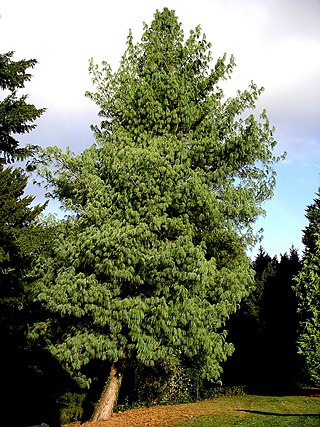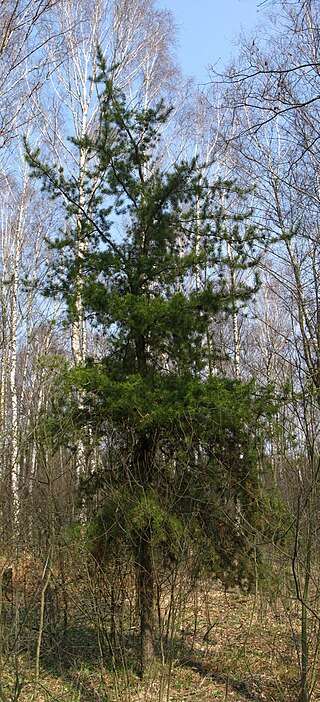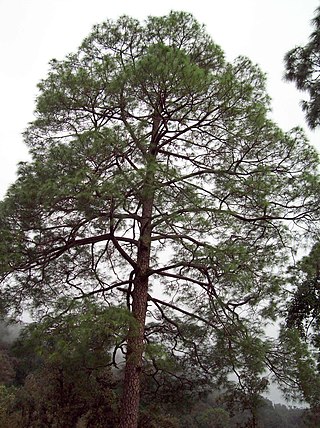
Pinus sabiniana, with vernacular names including towani pine, foothill pine, gray pine, bull pine, and digger pine, is a pine endemic to California in the United States. Some sources discourage using the name "digger pine," considering it pejorative.

Pinus parviflora, also known as five-needle pine, Ulleungdo white pine, or Japanese white pine, is a pine in the white pine group, Pinus subgenus Strobus, native to Korea and Japan.

Pinus wallichiana is a coniferous evergreen tree native to the Himalaya, Karakoram and Hindu Kush mountains, from eastern Afghanistan east across northern Pakistan and north west India to Yunnan in southwest China. It grows in mountain valleys at altitudes of 1800–4300 m, reaching 30–50 m (98–164 ft) in height. It favours a temperate climate with dry winters and wet summers. In Pashto, it is known as Nishtar.

Jack pine is an eastern North American pine. Its native range in Canada is east of the Rocky Mountains from the Mackenzie River in the Northwest Territories to Cape Breton Island in Nova Scotia, and the north-central and northeast of the United States from Minnesota to Maine, with the southernmost part of the range just into northwest Indiana and northwest Pennsylvania. It is also known as grey pine and scrub pine.
Pinus fenzeliana commonly known as the Hainan white pine or Fenzel's pine, is a tree endemic to the island of Hainan off southern China. This pine reaches heights of 20 m with a trunk 1 m in diameter.

Pinus sibirica, or Siberian pine, in the family Pinaceae is a species of pine tree that occurs in Siberia from 58°E in the Ural Mountains east to 126°E in the Stanovoy Range in southern Sakha Republic, and from Igarka at 68°N in the lower Yenisei valley, south to 45°N in central Mongolia.

Pinus merkusii, the Merkus pine or Sumatran pine, is a pine native to the Malesia region of southeast Asia, and the only one that occurs naturally south of the equator.

Pinus latteri, or Tenasserim pine, is a pine native to Mainland Southeast Asia.

Pinus roxburghii, commonly known as chir pine or longleaf Indian pine, is a species of pine tree native to the Himalayas. It was named after William Roxburgh.

Pinus ayacahuite, also called ayacahuite pine and Mexican white pine, is a species of pine native to the mountains of southern Mexico and western Central America, in the Sierra Madre del Sur mountains and the eastern end of the Eje Volcánico Transversal, between 14° and 21°N latitude in the Mexican states of Guerrero, Oaxaca, Puebla, Veracruz and Chiapas, and in Guatemala, El Salvador and Honduras. It grows on relatively moist areas with summer rainfalls, however specimens from its eastern and southern distribution live under really wet conditions; it needs full sun and well drained soils. Its temperature needs fluctuate between 19 and 10 °C on average a year. This tree accepts from subtropical to cool climate.

Pinus monophylla, the single-leaf pinyon, is a pine in the pinyon pine group, native to North America. The range is in southernmost Idaho, western Utah, Arizona, southwest New Mexico, Nevada, eastern and southern California and northern Baja California.

Pinus aristata, the Rocky Mountain bristlecone pine, is a long-living species of bristlecone pine tree native to the United States. It appears in the Rocky Mountains in Colorado and northern New Mexico, with isolated populations in the San Francisco Peaks in Arizona and the Kaibab National Forest north of the Grand Canyon. It is usually found at very high altitudes, from 7,000–13,000 feet (2,100–4,000 m), in cold, dry subalpine climate conditions, often at the tree line, although it also forms extensive closed-canopy stands at somewhat lower elevations.

Pinus gerardiana, commonly known as the chilgoza pine or neja is a pine native to the northwestern Himalayas in Afghanistan, northern Pakistan, Waziristan and northwestern India, growing at elevations of 1,800–3,350 metres (5,910–10,990 ft). It often occurs in association with Cedrus deodara and Pinus wallichiana.

Pinus hwangshanensis, or Huangshan pine, is a pine endemic to the mountains of eastern China; it is named after the Huangshan Mountains in Anhui, from where it was first described.

Pinus durangensis, the Durango pine, is a pine tree species endemic to the Sierra Madre Occidental mountain range of north-western Mexico.

Pinus maximartinezii, called Martinez pinyon, big-cone pinyon or maxipiñon, is a pine in the pinyon pine group, native to west-central Mexico.

Pinus massoniana is a species of pine, native to Taiwan, a wide area of central and southern China, and northern Vietnam.

Pinus dalatensis, also known as Vietnamese white pine or Dalat pine, is a species of pine endemic to Indochina. In Vietnam it grows in the mountains of the central and south-central parts of the country at elevations of 1,400 to 2,300 metres. Only recently confirmed from Laos, the population located within the Nakai-Nam Theun Biodiversity Conservation Area is the largest, at the lowest elevation, and the northernmost of the known populations of P. dalatensis.

Pinus devoniana is a species of conifer in the family Pinaceae. It is found in more than 15 states of Mexico - from S. Sinaloa to Chiapas - and Guatemala in montane, relatively open pine or pine-oak forests at altitudes from 900 to 2,500 m.

Pinus nelsonii, Nelson's pinyon, is a species of pine native to the mountains of northeastern Mexico, in Nuevo León, San Luis Potosí and Tamaulipas at 1,800–3,200 m altitude.




















